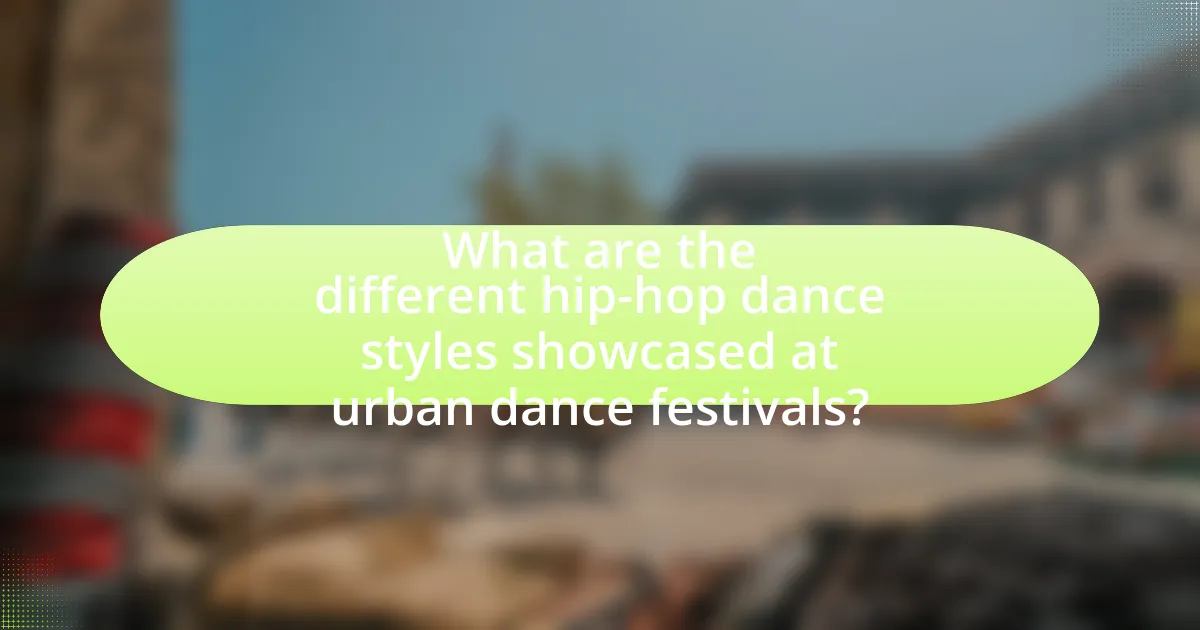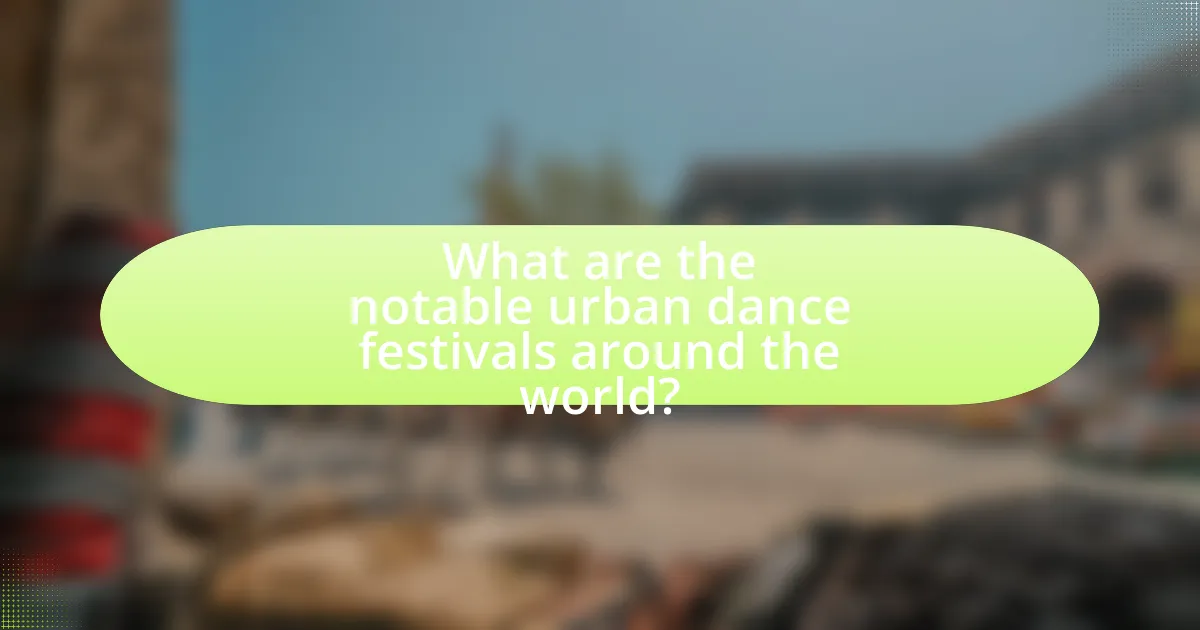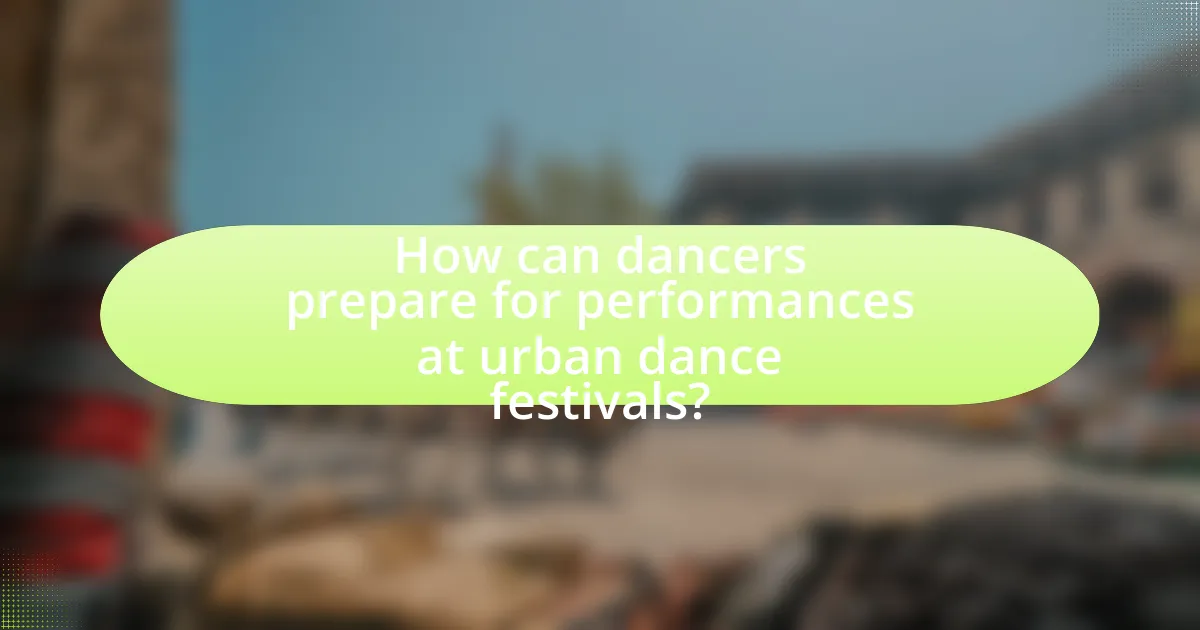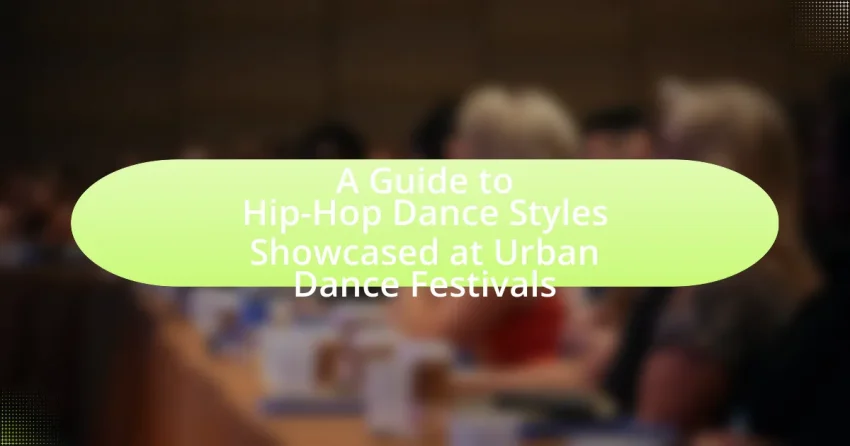The article provides a comprehensive guide to various hip-hop dance styles showcased at urban dance festivals, including breaking, locking, popping, and krumping. It explores the evolution of these styles, influenced by cultural movements and historical contexts, highlighting their unique characteristics and significance within hip-hop culture. Additionally, the article discusses the role of urban dance festivals in promoting community, collaboration, and competition, while also detailing notable events and the importance of personal style and audience connection in performances. Resources for aspiring dancers and effective training methods are also outlined, emphasizing the ongoing development and celebration of hip-hop dance.

What are the different hip-hop dance styles showcased at urban dance festivals?
Different hip-hop dance styles showcased at urban dance festivals include breaking, locking, popping, and krumping. Breaking, also known as breakdancing, originated in the 1970s and features acrobatic moves and spins. Locking, developed in the late 1960s, emphasizes distinct arm and hand movements combined with quick pauses. Popping, which emerged in the 1980s, involves contracting and relaxing muscles to create a jerking effect. Krumping, a more recent style from the early 2000s, is characterized by expressive and energetic movements. These styles are often highlighted in competitions and performances at urban dance festivals, reflecting the diversity and evolution of hip-hop culture.
How did hip-hop dance styles evolve over time?
Hip-hop dance styles evolved over time through a combination of cultural influences, innovation, and the emergence of various sub-genres. Initially, hip-hop dance began in the 1970s with foundational styles like breaking, which incorporated acrobatic moves and floor work, influenced by funk and disco music. As hip-hop culture spread, new styles emerged, such as locking and popping in the 1980s, which added more theatrical elements and showcased individual expression.
In the 1990s and 2000s, hip-hop dance further diversified with the introduction of styles like krumping and jerking, reflecting social issues and personal narratives. The rise of dance competitions and urban dance festivals, such as the World of Dance and Hip Hop International, provided platforms for these evolving styles, allowing dancers to showcase their skills and creativity. This evolution is marked by a continuous blending of street dance with commercial dance, leading to the incorporation of hip-hop elements in mainstream performances and media.
What historical influences shaped the development of hip-hop dance?
Hip-hop dance developed significantly due to influences from African American culture, street dance styles, and social movements. The emergence of hip-hop in the 1970s in the Bronx, New York, was marked by the blending of various dance forms, including breakdancing, locking, and popping, which were rooted in earlier African American dance traditions. Additionally, the socio-political climate, including the Civil Rights Movement, played a crucial role in shaping the dance as a form of expression and resistance. The popularity of hip-hop music and the rise of block parties further facilitated the evolution of these dance styles, creating a vibrant community that celebrated creativity and individuality.
How have cultural movements impacted hip-hop dance styles?
Cultural movements have significantly shaped hip-hop dance styles by introducing new themes, techniques, and expressions that reflect societal changes. For instance, the civil rights movement in the 1960s influenced hip-hop dance by incorporating elements of protest and empowerment, leading to styles that emphasized individuality and social commentary. Additionally, the rise of street culture in the 1980s and 1990s brought about breakdancing and locking, which were rooted in the experiences of marginalized communities. These styles often served as a form of resistance and identity, showcasing the dancers’ backgrounds and struggles. The evolution of hip-hop dance continues to be impacted by contemporary cultural movements, such as those advocating for racial equality and LGBTQ+ rights, further diversifying the styles and narratives within the dance community.
What are the key characteristics of popular hip-hop dance styles?
Popular hip-hop dance styles are characterized by their energetic movements, improvisation, and strong connection to hip-hop culture. Styles such as breaking, locking, and popping each have distinct features; breaking includes acrobatic moves and floor work, locking emphasizes rhythmic, exaggerated movements, and popping focuses on quick muscle contractions to create a jerky effect. These styles often incorporate elements of street dance and are influenced by music genres like funk and rap, reflecting the cultural and social contexts from which they emerged. The dynamic nature of these dances allows for personal expression and creativity, making them integral to hip-hop culture and performance.
What defines breaking as a hip-hop dance style?
Breaking is defined as a dynamic hip-hop dance style characterized by its athletic movements, including toprock, downrock, freezes, and power moves. This style originated in the 1970s in the South Bronx and is heavily influenced by various dance forms, martial arts, and acrobatics. Breaking is often performed to hip-hop music and emphasizes improvisation and individual expression, making it a key element of hip-hop culture. The competitive aspect of breaking, showcased in battles, further solidifies its identity within the hip-hop dance community.
How does locking differ from other hip-hop dance styles?
Locking differs from other hip-hop dance styles primarily through its distinctive rhythmic and mechanical movements, characterized by sudden pauses or “locks” in the dance. Unlike styles such as breaking or popping, which emphasize fluidity and acrobatics, locking incorporates exaggerated, playful gestures and a strong connection to funk music, originating in the late 1960s. The style was popularized by dancers like Don Campbell, who created specific movements like the “Lock” and “Scoo B Doo,” which are integral to its identity. This unique combination of rhythm, personality, and musicality sets locking apart from other hip-hop styles, which may focus more on athleticism or improvisation.
What are the unique features of popping in hip-hop dance?
Popping in hip-hop dance is characterized by its distinct technique of quickly contracting and relaxing muscles to create a jerking motion, known as “pop.” This style emphasizes sharp, isolated movements, often synchronized with the rhythm of the music. Unique features include the use of various techniques such as the “wave,” which mimics fluid motion, and “robot,” which creates a mechanical appearance. Popping also incorporates elements of freestyle, allowing dancers to express individuality while maintaining a strong connection to the beat. The style originated in the late 1960s and gained popularity through the funk music scene, particularly influenced by artists like the Electric Boogaloos.
Why are urban dance festivals important for hip-hop culture?
Urban dance festivals are crucial for hip-hop culture as they serve as platforms for showcasing diverse dance styles, fostering community, and promoting cultural exchange. These festivals highlight various hip-hop dance forms, such as breaking, locking, and popping, allowing dancers to demonstrate their skills and creativity. Additionally, they create a sense of belonging among participants and audiences, reinforcing the communal aspect of hip-hop culture. Events like the World Hip Hop Dance Championship attract thousands of dancers and spectators, emphasizing the global reach and influence of hip-hop. Such gatherings not only celebrate the art form but also educate attendees about its history and evolution, ensuring the culture’s continuity and relevance.
How do urban dance festivals promote community and collaboration?
Urban dance festivals promote community and collaboration by bringing together diverse groups of dancers, artists, and audiences to celebrate hip-hop culture. These festivals create a shared space where participants can engage in workshops, performances, and competitions, fostering connections among individuals from various backgrounds. For instance, events like the World Hip Hop Dance Championship attract thousands of dancers globally, encouraging cultural exchange and teamwork. Additionally, community-driven initiatives within these festivals often include local dance crews collaborating on performances, which strengthens local ties and enhances the sense of belonging among participants.
What role do competitions play in urban dance festivals?
Competitions serve as a central element in urban dance festivals by providing a structured platform for dancers to showcase their skills and creativity. These competitions foster a sense of community and encourage artistic expression among participants, as they often feature various styles of hip-hop dance, allowing for diverse performances. Additionally, competitions can enhance the visibility of emerging talent, as many festivals attract industry professionals who scout for new dancers. The competitive aspect also motivates dancers to refine their techniques and innovate their routines, contributing to the overall evolution of hip-hop dance culture.

What are the notable urban dance festivals around the world?
Notable urban dance festivals around the world include the World Hip Hop Dance Championship in the United States, Juste Debout in France, and the Hip Hop International in Las Vegas. The World Hip Hop Dance Championship, held annually, attracts thousands of dancers from over 50 countries, showcasing various hip-hop styles. Juste Debout, known for its focus on street dance styles, features competitions in locking, popping, and house dance, drawing international participants. Hip Hop International, also a major event, serves as a platform for dancers to compete and represent their countries, further emphasizing the global nature of urban dance culture.
How do different festivals highlight various hip-hop dance styles?
Different festivals highlight various hip-hop dance styles by featuring competitions, workshops, and performances that showcase specific techniques and cultural influences. For instance, events like the World Hip Hop Dance Championship emphasize styles such as breaking, locking, and popping, allowing dancers to compete and demonstrate their skills in front of an international audience. Additionally, festivals like the Hip Hop International provide workshops led by renowned dancers, which educate participants on the history and evolution of these styles, further promoting their significance within the hip-hop community. These festivals serve as platforms for both established and emerging dancers to express their artistry, connect with peers, and celebrate the diversity of hip-hop dance.
What specific styles are emphasized at the World of Dance events?
The specific styles emphasized at the World of Dance events include hip-hop, street dance, breaking, locking, and popping. These styles are showcased through various competitions and performances, highlighting their cultural significance and technical complexity. The World of Dance events serve as a platform for dancers to demonstrate their skills in these genres, which are integral to urban dance culture and have gained global recognition.
How does the Juste Debout festival showcase street dance styles?
The Juste Debout festival showcases street dance styles through competitive battles that highlight various forms such as hip-hop, locking, popping, and house. This international event attracts dancers from around the world, providing a platform for them to demonstrate their skills and creativity in front of a diverse audience. The festival emphasizes the cultural significance of street dance by featuring workshops, performances, and showcases that celebrate the artistry and evolution of these dance styles.
What are the unique features of each festival?
Urban dance festivals showcase unique features that distinguish them from one another. For example, the Juste Debout festival in France emphasizes street dance styles like locking and popping, attracting international competitors and offering workshops led by renowned dancers. In contrast, the World Hip Hop Dance Championship in the USA focuses on competitive team performances, featuring diverse hip-hop styles and a high-energy atmosphere that celebrates creativity and innovation. Additionally, the Hip Hop International festival promotes cultural exchange by bringing together dancers from various countries, highlighting regional styles and fostering collaboration. Each festival’s distinct focus on specific dance styles, competitive formats, and cultural representation contributes to its unique identity within the urban dance scene.
What types of performances can attendees expect at these festivals?
Attendees can expect a variety of hip-hop dance performances at urban dance festivals, including breakdancing, locking, popping, and freestyle battles. These performances often feature both solo and group routines, showcasing the technical skills and creativity of dancers. For instance, breakdancing, which originated in the 1970s, emphasizes acrobatic moves and intricate footwork, while locking and popping focus on rhythmic body movements and isolations. Additionally, many festivals host competitions that highlight emerging talent and established artists, providing a platform for diverse expressions within the hip-hop dance community.
How do workshops at urban dance festivals enhance learning?
Workshops at urban dance festivals enhance learning by providing hands-on experience and direct interaction with skilled instructors. These workshops allow participants to practice various hip-hop dance styles in a structured environment, facilitating skill development and technique refinement. Research indicates that experiential learning, such as that found in workshops, significantly improves retention and understanding of complex movements, as participants can receive immediate feedback and adjust their techniques accordingly. Additionally, the collaborative atmosphere fosters community engagement and encourages peer learning, further enriching the educational experience.

How can dancers prepare for performances at urban dance festivals?
Dancers can prepare for performances at urban dance festivals by focusing on rigorous practice, understanding the festival’s style, and ensuring physical and mental readiness. Consistent rehearsals help dancers refine their techniques and choreography, while studying the specific hip-hop styles featured at the festival allows them to tailor their performances accordingly. Additionally, maintaining physical fitness through strength training and flexibility exercises is crucial, as is mental preparation through visualization techniques and stress management strategies. These methods enhance performance quality and boost confidence, which is essential for success in competitive environments like urban dance festivals.
What training methods are effective for mastering hip-hop dance styles?
Effective training methods for mastering hip-hop dance styles include structured classes, online tutorials, and practice sessions. Structured classes provide professional instruction and feedback, which is essential for learning complex movements and techniques. Online tutorials offer flexibility and access to a variety of styles and choreographies, allowing dancers to learn at their own pace. Regular practice sessions reinforce skills and build muscle memory, which is crucial for executing hip-hop dance moves fluidly. Research indicates that consistent practice and exposure to diverse teaching methods significantly enhance a dancer’s proficiency and adaptability in hip-hop styles.
How can dancers improve their technique and performance skills?
Dancers can improve their technique and performance skills through consistent practice, targeted training, and feedback. Regular practice enhances muscle memory and coordination, while targeted training focuses on specific areas such as flexibility, strength, and rhythm. Feedback from instructors or peers provides insights into areas needing improvement, allowing dancers to refine their skills effectively. Research indicates that structured training programs can lead to significant advancements in performance quality, as seen in studies on dance education methodologies.
What role does choreography play in festival performances?
Choreography plays a crucial role in festival performances by structuring the dance routines that convey artistic expression and cultural narratives. In urban dance festivals, well-crafted choreography enhances the visual impact of performances, allowing dancers to showcase their skills and styles effectively. For instance, specific hip-hop dance styles, such as breaking or locking, rely on intricate choreography to highlight the unique movements and techniques associated with each style, thereby engaging the audience and creating a memorable experience.
What tips can dancers follow to stand out at urban dance festivals?
Dancers can stand out at urban dance festivals by showcasing unique styles, strong stage presence, and engaging with the audience. Unique styles, such as incorporating personal flair or blending different dance genres, can capture attention. A strong stage presence, characterized by confidence and energy, helps dancers connect with the audience and judges. Engaging with the audience through eye contact and interaction enhances the performance experience. These elements are crucial as they differentiate dancers in a competitive environment, where originality and charisma are highly valued.
How important is personal style in hip-hop dance performances?
Personal style is crucial in hip-hop dance performances as it distinguishes individual dancers and enhances their artistic expression. In hip-hop culture, personal style reflects a dancer’s identity, influences their movement choices, and contributes to the overall performance aesthetic. The importance of personal style is evidenced by the fact that many successful hip-hop dancers and choreographers, such as Poppin’ Pete and Jabbawockeez, have built their careers on unique styles that resonate with audiences and set trends within the dance community.
What strategies can dancers use to connect with the audience?
Dancers can connect with the audience by using eye contact, expressive body language, and engaging storytelling through their movements. Eye contact establishes a personal connection, making the audience feel involved in the performance. Expressive body language conveys emotions and intentions, allowing the audience to relate to the dancer’s experience. Engaging storytelling through choreography helps to create a narrative that resonates with viewers, enhancing their emotional investment in the performance. These strategies are supported by research indicating that audience engagement increases when performers actively involve viewers through visual and emotional cues.
What resources are available for aspiring hip-hop dancers?
Aspiring hip-hop dancers can access a variety of resources including online tutorials, dance classes, workshops, and community events. Online platforms like YouTube offer free instructional videos from experienced dancers, while websites such as DancePlug and Steezy provide structured courses for a fee. Local dance studios often host classes specifically focused on hip-hop styles, and many urban dance festivals feature workshops led by professional dancers, providing hands-on experience. Additionally, social media platforms like Instagram and TikTok serve as spaces for dancers to share their work and connect with others in the hip-hop community, fostering collaboration and inspiration.
Where can dancers find online tutorials and classes?
Dancers can find online tutorials and classes on platforms such as YouTube, Udemy, and Skillshare. YouTube offers a vast array of free dance tutorials from various instructors, covering different hip-hop styles. Udemy and Skillshare provide structured courses, often taught by professional dancers, which can be accessed for a fee. These platforms are widely recognized for their educational content, making them reliable sources for learning dance techniques and styles.
What are the benefits of joining local dance communities?
Joining local dance communities offers numerous benefits, including enhanced social connections, skill development, and increased motivation. These communities provide a supportive environment where dancers can meet like-minded individuals, fostering friendships and collaboration. Additionally, participating in local dance groups often leads to improved dance techniques through shared knowledge and practice opportunities. Research indicates that social engagement in dance can boost mental well-being and reduce stress, further validating the positive impact of these communities on individuals’ overall health.
